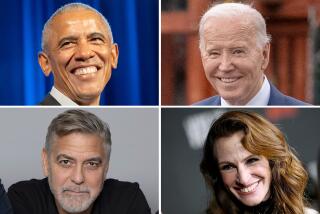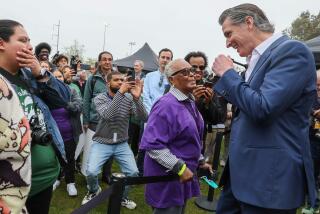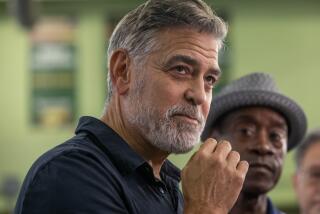$93,572 an Hour : Pope’s Visit: Innovations Pay for It
- Share via
Catholic leaders, seeking creative ways to raise $20 million to pay for Pope John Paul II’s nine-day coast-to-coast U.S. visit this September, have auctioned a steer in Texas, accepted the use of 100 automobiles in Detroit, tapped a wealthy foundation in Los Angeles and staged a round of high-tab celebrity dinners in San Francisco.
“We’re trying very hard to raise the money without fleecing the flock,” said Father Miles Riley of the Archdiocese of San Francisco, which has budgeted $3.3 million for the Pope’s 21-hour stop in that city.
Innovative fund raising is indeed necessary: It will cost the American Roman Catholic Church an average of $93,572 an hour for the pontiff’s Sept. 10-19 tour.
And that does not count an estimated $50,000 an hour U.S. taxpayers must pay for security, crowd control and other government services during the trip. To protect the Pope, the U.S. Secret Service budget alone is $5.7 million. A spokesman for the agency said the cost could not be compared meaningfully to federal expenses incurred when other heads of state visit the United States “because each situation is so different.”
Protests From Nuns
Some critics contend that the price tag for the pontiff’s 222-hour U.S. swing is too high.
Complaints have included protests from two groups of Catholic nuns that the money could be better spent on the nation’s homeless and financially sagging inner-city parochial schools.
Leaders planning the trip insist, however, that it is worth it.
“The money is well spent for the Catholics of the United States to host their pontiff . . . who is Christ’s vicar on Earth,” said Carl Eifert, a spokesman for the National Conference of Catholic Bishops.
Big-buck items include stadium leases (one night’s rental for the Los Angeles Coliseum is $125,000), liability insurance, sound equipment, altars, scaffolds, chairs and even portable toilets.
$307,692 an Hour
Hourly costs, based on working budgets submitted by the nine regions, compute from a low of $56,338 in New Orleans, where the Pope will spend 35 1/2 hours, to a high of $307,692 in Monterey and Carmel, where John Paul will stay less than seven hours. In Los Angeles, where Archbishop Roger Mahony has put a $3-million cap on costs for the 46 1/2 hours the pontiff will be in town, the hourly figure is $64,516.
Other cities on the tour, which is expected to reach tens of millions of U.S. Catholics in person and through radio and television, are Miami, Columbia, S.C.; San Antonio, Phoenix and Detroit.
In addition to these costs--borne by the dioceses playing host to the Pope--$2 million, largely for media and public relations expenses, must be raised by the national office of the U.S. Catholic Church.
John Paul’s visit to the United States--his second as Pope, after a six-city tour in 1979--coincides with a $63-million deficit at the Vatican, which is depending on Catholics in affluent countries to erase the red ink.
Nearly all expenses of the Pope’s numerous trips abroad are financed by the hosting churches and, since John Paul is a recognized head of state, by the governments of the countries he visits. These governments typically underwrite the costs of security and extra services.
Church officials note that if every U.S. Catholic would kick in, the high-priced U.S. endeavor would work out to no more than 40 cents per parishioner. And leaders calculate that if the church’s costs were divided by the number of people admitted to the papal Masses and other ticketed events, the tab would be $15.
But all tickets will be free.
In fact, when the Diocese of Monterey proposed an assessment of $15 for each admission ticket and the sale of television rights to high-bidding stations for coverage of the huge Mass at Laguna Seca Raceway, howls of protest quickly persuaded diocesan leaders to scrap the plan.
And no memorabilia--like the papal T-shirts, beer mugs and “popesicle” bars that inevitably show up wherever John Paul goes--will be endorsed or marketed by the church. Official commemorative booklets and coins are planned in several cities, however.
Creative Fund Raising
Most dioceses are relying on creative techniques of voluntary fund raising, counting on generous contributions from the Catholic and non-Catholic populace and banking on the largess of public relations-conscious business firms to boost them over the budget hurdle. Two months before the Pope’s scheduled arrival, most of the dioceses were at or slightly above the halfway mark in reaching their budget goals, according to local officials.
Political-style fund raising is in high gear in San Francisco, Miami and Phoenix, where the resident bishops are lobbying the wealthy.
San Francisco Archbishop John R. Quinn was the guest of honor at a $250-a-plate dinner party Thursday in the home of Mayor Dianne Feinstein. A string of 10 similar fund-raisers, including a $200-a-plate gala hosted by the owners of the renowned restaurant Ernie’s, has been put together by some of the city’s most powerful and wealthy people. The committee’s 55 members, about a third of whom are Jews and Protestants, have pledged to raise $1 million toward the $3.3-million visit budget.
The committee includes the mayor’s husband, investment banker Richard Blum; prominent San Francisco socialite Charlotte Mailliard, and California Democratic Party leaders, including Walter Shorenstein, who owns or manages more than a quarter of downtown San Francisco.
Feinstein, who is Jewish, has been criticized by some Jews for holding the fund-raiser in light of the Pope’s June 25 audience with Austrian President Kurt Waldheim. The mayor said she had agreed to host the affair before the Vatican meeting with Waldheim, who worked for the Nazis during World War II.
Memorial Plaque
Some Jews who have traditionally been strong supporters of Catholic causes in San Francisco have backed away from contributing to the papal visit fund because of the issue. Among those declining to attend Feinstein’s dinner was Melvin Swig, whose family owns the Fairmont Hotel and has contributed millions of dollars through the years to Bay Area Catholic universities. Swig also resigned from the 55-member committee.
Those who give $1,000 or more to the San Francisco drive will have their names engraved on a memorial plaque to be enshrined in a “hall of honor” in St. Mary’s Cathedral, where the Pope will hold several key meetings on Sept. 17 and 18.
The Phoenix drive to raise $1.5 million includes a committee of 90 “leading citizens”; among them are baseball announcer Joe Garagiola, columnist Erma Bombeck and Albert Plotkin, one of the city’s leading rabbis.
In Miami, where Archbishop Edward McCarthy kicked off a fund drive with a talk to wealthy business leaders, church officials are also sensitive to criticism that money for the Pope’s visit could be spent instead on feeding the poor. Parishioners there are being asked to make a contribution to the poor the week before John Paul arrives.
In San Antonio, Archbishop Patrick Flores is spending many of his summer evenings meeting in homes, seeking contributions from groups of poor and middle-class parishioners.
Citywide Dinner
The Texas papal visit budget of $2.5 million--shared by the 4.5 million Catholics in the state’s 14 dioceses--has already been blessed by several major benefactors. Three landowners donated the use of 144 acres for a gigantic outdoor Mass on Sept. 13, as well as $35,000 to clear and landscape the site. In addition, a citywide dinner for the archbishop raised $100,000.
A highlight of the evening was the auction of Drummer, a champion longhorn steer, which fetched $5,000.
If Texas gives beef, Detroit gives cars. General Motors is lending 100 new white Pontiac Bonnevilles with maroon interiors (they carry a sticker price of $19,800 each) to the Archdiocese of Detroit for papal dignitaries to use for a month beginning Aug. 24.
In San Francisco, Christian Brothers Winery has provided 60 cases of altar wines; in Monterey, $165,000 worth of computer equipment and counterfeit-proof ticket printing has been donated and in Phoenix, mining companies are contributing a 65-foot copper cross to adorn Arizona State University’s stadium for a Mass on the night of Sept. 14.
In New Orleans, Lennox China and Crystal has donated a 225-piece gold-edged china service and matching crystal for 24, valued at more than $11,000. Singer Debbie Boone has pledged $1 for every ticket sold to her performances in “The Sound of Music” there.
$500,000 Donation
The largest single gift is $500,000, bestowed by the Dan Murphy Foundation of Los Angeles in response to a phone call from Mahony. The foundation, established by Catholic heirs of the Portland Cement Co. and Standard Oil of California, regularly gives millions of dollars to the Los Angeles Archdiocese and is one of the nation’s largest religious foundations.
Funds will also come in from other foundations, $5 donations for a full-color commemorative booklet of the Pope’s visit and a special collection in archdiocesan parishes on Aug. 29 and 30, Mahony said. He added that he hopes donated goods and services will substantially shave the $3-million budget.
Thousands of volunteer workers will contribute a bundle in free services by ushering, directing traffic and constructing ramps and altars for the Masses the Pope will hold in Los Angeles and other cities.
In San Francisco, a corps of 1,000 janitors from Union Local 87 will save the archdioceses thousands of dollars by blitzing through a free cleanup job in 20 minutes at Candlestick Park at the end of the Mass there on Sept. 18. Normally, it takes 45 workers about eight hours to clean up after a San Francisco Giants game, the union president said.
Some basic necessities do not come cheap: To provide 850 portable toilets needed for the crowds in Monterey, 600 extras must be imported from San Jose--at a cost of $32,000.
Major Governmental Bills
Meanwhile, state and local governments will run up major bills handling the expected record crowds in most of the cities John Paul visits.
“Nobody’s totaled up these aggregate costs,” Father Robert Lynch, the U.S. coordinator for the the papal visit, said during an interview in his Washington office.
An informal survey by The Times found that financial information from regional law enforcement authorities was often unavailable or sketchy.
Los Angeles police officials refused to reveal their projected budget for protecting the Pope, saying they never release such figures for visiting dignitaries for fear that terrorists could get a fix on the planned level of security.
In most cases, multiple agencies are involved in protecting the Pope and his entourage, expediting the flow of vehicles and pedestrians and covering fire, crime and medical emergencies.
In Arizona, for instance, where the pontiff will stay for 24 hours, the Department of Public Safety, the Maricopa County Sheriff’s Department, the Phoenix Police Department, the Tempe Police Department, the National Guard, the Secret Service and the Security Police at Arizona State University will be in on the action as the Pope moves from event to event.
$100,000 in Phoenix
Sgt. Denis Reagan of the Phoenix Police Department estimated that the papal visit will cost his department about $100,000. Echoing many of the law agencies contacted by The Times, Reagan said his department will take the money out of regular budget and try to eliminate overtime as much as possible.
In Florida, where the Pope is scheduled to meet with President and Nancy Reagan, state taxpayers will pay for papal security out of a $1.5-million appropriation recently passed by the state Legislature. The money will pay overtime for about 1,000 law officers and provide $175,000 to improve Tamiami Park in Dade County, where the Pope will celebrate Mass on Sept. 11 for an expected 500,000 people. About 2,000 National Guard troops will also be on hand.
Maj. Dean DeJong, coordinator of services for the City of Miami, said the “top-end figure” for providing public safety and other services during the Pope’s visit is $400,000, including $200,000 for overtime.
DeJong acknowledged that there is concern over the church-state issue of government funds being spent for the visit of a religious leader.
“The money we’re spending is aimed only at the security of the head of state (the Pope) and the safety of the general public,” he said.
Kurt Steiner, New Orleans chief administrative officer, said that city’s cost for police and fire protection would be $500,000.
‘Hidden Benefits’
“But there’s more to it than the dollars and cents,” he added, saying that the Pope’s visit to the predominantly Catholic city would also generate “hidden benefits. . . . We are certainly going to get tax revenues from people staying in hotels and buying merchandise.”
That possibility was not lost on the merchants of Columbia, where the pontiff will pay a five-hour call in territory that is only 2% Roman Catholic.
Msgr. Thomas Duffy of the Charleston Diocese declared that most of the diocese’s $473,000 budget is being raised by South Carolina business leaders “who understand the economic impact of the Pope’s visit.” The pontiff’s presence is expected to temporarily swell Columbia’s population to three times its normal 100,000.
Nearly 75% of the $2 million to be raised by the U.S. Catholic Conference is for “the care and feeding” of the press, according to Lynch, who said that $500,000 of the total will be used to set up media centers, where journalists will prepare their stories, in each of the host cities.
Publicity Value
To papal visit planners, whatever it costs to get the Pope in the public eye is a good investment.
The visit “is $2 billion worth of publicity alone,” said Riley, the San Francisco spokesman.
Added Ted Elisee, director of communications for the Diocese of Monterey: “I cannot think of any event that would unite the community--along racial, religious and political lines--better than this visit. People of this community are going to unite and pray together. And once unity comes about, it’s easier to maintain.”
PAYING FOR THE POPE’S VISIT
Budgeted cost to Stay Est. cost City local churches in hours per hour Miami $2,000,000 23.5 $85,106 Columbia, S.C. 473,000 5.0 94,600 New Orleans 2,000,000 35.5 56,338 San Antonio 2,500,000 22.5 111,111 Phoenix 1,500,000 24.0 62,500 Los Angeles 3,000,000 46.5 64,516 Monterey/Carmel 2,000,000 6.5 307,692 San Francisco 3,300,000 21.0 157,142 Detroit 2,000,000 23.0 86,956 U.S. Catholic Office 2,000,000* 222.0** 9,009 Totals: $20,773,000 222.0 $93,572
* not budgeted to local churches
** Includes 14.5 hours air travel time not assigned to specific cities
More to Read
Sign up for Essential California
The most important California stories and recommendations in your inbox every morning.
You may occasionally receive promotional content from the Los Angeles Times.










